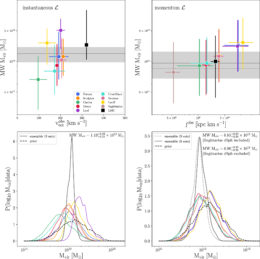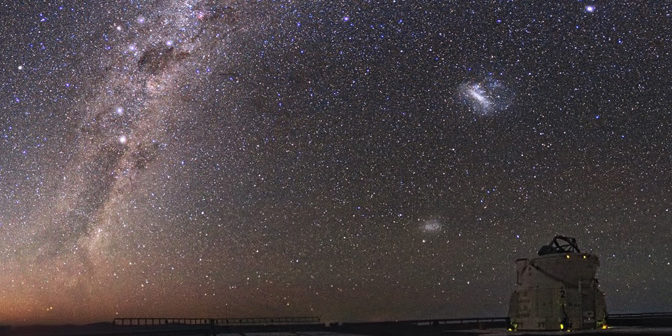Weighing galaxies is a tricky business — especially when that galaxy is our own! In a recent study, scientists have tackled this problem by harnessing incredibly precise measurements of the motions of Milky-Way satellites.
A Challenging Measurement

Locations of some of the ~50 satellite galaxies known around the Milky Way. [AndrewRT]
So what’s the key to precisely weighing the Milky Way? A new study led by Ekta Patel (University of Arizona) — presented at the American Astronomical Society meeting two weeks ago — suggests it may be the barely preceptible motions of the small satellite galaxies that orbit around the Milky Way. Around 50 Milky-Way satellites are currently known, and simulations suggest that there may be up to 100–200 in total. By watching the motions of these satellites, we can trace the potential of their host — the Milky Way — and estimate its mass.

The Illustris-Dark simulation evolves our universe to the present day, providing a view of how dark matter organizes itself into galaxy halos over time. [Illustris Collaboration]
Tiny Motions of Tiny Galaxies
In this era of precision astronomy, remarkable measurements are becoming possible. In their study, Patel and collaborators use years of proper-motion observations from the Hubble Space Telescope for nine satellite galaxies of the Milky Way. The precision needed for measurements like these is insane: watching these satellites move is roughly like watching a human hair grow at the distance of the Moon.
Rather than using the instantaneous position and velocity measured for a satellite — which changes over time during the satellite’s orbit — Patel and collaborators demonstrate that the satellite’s specific angular momentum is a more useful parameter when attempting to estimate its host galaxy’s mass.
For each of the nine individual satellite galaxies, the authors compare its measured momentum to that of ~90,000 simulated satellite galaxies from the Illustris-Dark cosmological simulation. This matching is used to build a probability distribution for the mass of the host galaxy most likely to be orbited by such a satellite. The probability distributions for the nine satellite galaxies are then combined to find the best overall estimate for the Milky Way’s mass.
Tipping the Scale

Top: summary of the most likely Milky-Way mass estimated from each of the 9 satellite galaxies, using the instantaneous positions and velocities (left) and the momentum (right) of the satellites. The momentum method shows less scatter in the host masses. Bottom: probability distributions for the most likely Milky-Way mass for each of the satellites (colored curves) and combined (grey curve). Click for a better look. [Patel et al. 2018]
The authors only had access to precise proper motions for nine satellite galaxies when they conducted their study — but since then, the Gaia mission has provided measurements for 30 satellites, with more expected in the future. Including these additional satellites and using improved, higher-resolution cosmological simulations for comparison will continue to increase the precision of Patel and collaborators’ estimate in the future.
In addition, this approach can also be used to weigh our neighboring Andromeda galaxy, or any other galaxy for which we’re able to get precise proper-motion measurements for its satellites. Keep an eye out in the future, as techniques like this continue to reveal more properties of our local universe.
Citation
Ekta Patel et al 2018 ApJ 857 78. doi:10.3847/1538-4357/aab78f

13 Comments
Pingback: How Massive Is the Milky Way? | Gadgetvibe | Technology Made Easy
Pingback: ¿Qué tan masiva es la Vía Láctea? ⋆ Eres Viral
Pingback: ¿Qué tan masiva es la Vía Láctea? ⋆ Eres Viral
Pingback: How Massive Is the Milky Way? - SoSialPolitiK
Pingback: How Massive Is the Milky Way? – News Online
Pingback: How Massive Is the Milky Way? - Dragmojo Tech Stories
Pingback: ¿Qué tan masiva es la Vía Láctea? ⋆ Lucky Viral
Pingback: How Massive Is the Milky Way? - Times of News India
Pingback: How Massive Is the Milky Way? - The Best of Everything
Pingback: كيف الضخمة هي درب التبانة؟ - Digital tech
Pingback: É possível pesar a nossa Galáxia? - ATENA
Pingback: How Huge Is the Galaxy? - Science and Tech News
Pingback: De massa van het Melkwegstelsel is 0,96 biljoen keer de zonsmassa